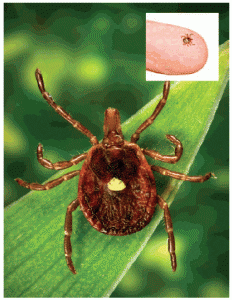

Six new cases of Heartland virus disease have been identified in residents of Missouri and Tennessee. The cause of this disease appears to be a member of the Phlebovirus genus in the Bunyaviridae family that was first identified in 2009 and appears to be transmitted by the Lone Star tick (Amblyomma americanum, pictured).
Heartland virus was first identified in two Missouri farmers who were hospitalized with fever, leukopenia (low numbers of white blood cells), and thrombocytopenia (low numbers of platelets). Both were males over 55 years old who reported being bitten by ticks in the week before disease onset. The novel virus was identified by electron microscopy, viral culture, and genome sequencing. For a complete discussion of this case, listen to This Week in Virology #199.
The tick A. americanum was implicated in transmission of Heartland virus because this species is extremely abundant in central and southern Missouri. However, virus was not isolated from ticks.
Since the description of the first two cases of Heartland virus disease, the Centers for Disease Control and Prevention have worked with state and local partners to develop diagnostic tests and identify additional cases. The six new cases were identified in 2012-13 in men over 50 years of age with fever, leukopenia, and thrombocytopenia. Presence of Heartland virus was determined by polymerase chain reaction using blood or tissue specimens, and by detecting a rise in antibodies against the virus in serum samples taken during and after illness. All six patients spent hours outdoors each day, and five reported tick bites in the two weeks preceding illness onset.
These studies strongly suggest but do not prove that Heartland virus was transmitted by ticks to these patients. One important piece of information will be finding Heartland virus in ticks. A first step is the identification of viral RNA sequences by polymerase chain reaction from ticks captured on the farms of the first two Missouri patients.
These findings raise several interesting questions. Why have the 8 patients with Heartland virus disease all been elderly males? Has this virus been present in the US for some time, and we have just detected it, or was it introduced from elsewhere? Does the virus circulate only in Missouri and Tennessee, and might it be found in other species of tick? Is there an animal reservoir as has been suggested? And what is the relationship of Heartland virus with the phlebovirus that causes severe fever with thrombocytopenia syndrome (SFTSV), an emerging disease in China that has also been detected in Japan and South Korea? Nucleotide sequence analysis reveals that Heartland viruses and SFTSV are highly related.

Pingback: Heartland virus disease | Tools and tips for sc...